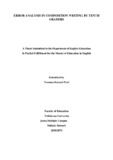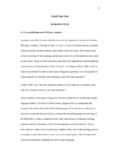Please use this identifier to cite or link to this item:
https://elibrary.tucl.edu.np/handle/123456789/1793| Title: | Error Analysis in Composition Writing by Tenth Graders |
| Authors: | Puri, Yamuna Kumari |
| Keywords: | Analysis;Composition;English Education |
| Issue Date: | 2019 |
| Publisher: | Department of Education English Janata Multiple Campus, Itahari Sunsari |
| Abstract: | The research entitled Error Analysis in Composition Writing by Tenth Graders is an attempt to identify and describe the grammatical errors. The research also aimed to classify the errors in terms of grammatical and semantic aspects of linguistic area and to put the pedagogical implications. In order to accomplish the objectives of the study, both primary and secondary sources of data have been used. The sample size of the study consists of 50 students selected through simple random sampling procedure. To carry out the research, essay type test item in SEE model was administered as a tool in each five school of Dharan sub-metropolitan city. The research was carried out under the survey design. The collected data have been analyzed, interpreted and presented descriptively as well as with the help of tables.From the study, it was found that grammar error found to be the most problematic area for secondary language learners while writing essays. In comparison, semantic errors were found to be quite less than the grammatical error. From the study it was found that article, preposition, s-v agreement and punctuations errors are the common errors in writing free composition (Essay). Among them S-V agreement was the most problematic for the second language learners. From the semantic analysis, in terms of nouns, verbs, adjectives and adverb, it was found that most of the semantic errors occurred due to wrong selection of adjective. The thesis consists of five chapters, chapter one deals with general background of error analysis, history, stages, lapses, mistakes and errors, and uses of EA, statement of the problem, Rational of the study, objectives of the study, Research questions, significance of the study and delimitation of the study. Chapter two is review of the related literature which consists of theoretical, empirical and conceptual framework. Chapter three related to methods and procedure of the study which encompasses study designing, sources of data, data collection tools, sample of population, sampling procedure and data collection procedures. Chapter four deals with results and discussion of the data. Chapter five presents summary, conclusion and implications with further recommendations. |
| URI: | http://elibrary.tucl.edu.np/handle/123456789/1793 |
| Appears in Collections: | English Language Education |
Files in This Item:
| File | Description | Size | Format | |
|---|---|---|---|---|
| Cover Page(3).pdf | 69.28 kB | Adobe PDF |  View/Open | |
| Chapter Page(1).pdf | 181.33 kB | Adobe PDF |  View/Open |
Items in DSpace are protected by copyright, with all rights reserved, unless otherwise indicated.
